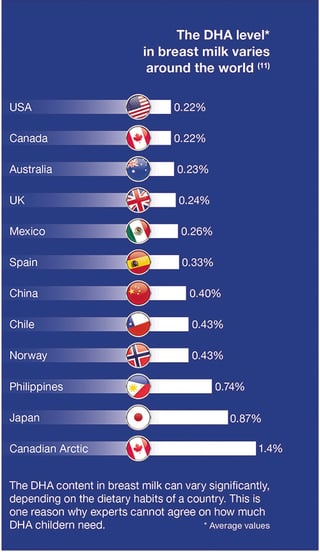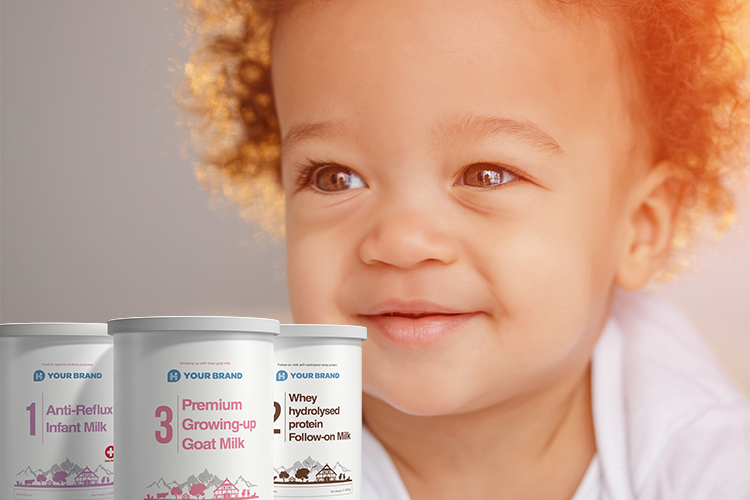 Our brain operates using many complex processes. It’s no surprise that it takes around twenty years to mature. A child’s brain needs omega-3 fatty acid DHA to develop in the best possible way, but our modern-day eating habits often neglect this resource. This is one of the reasons why the EU has decided to legislate the amount of DHA added to infant formula.
Our brain operates using many complex processes. It’s no surprise that it takes around twenty years to mature. A child’s brain needs omega-3 fatty acid DHA to develop in the best possible way, but our modern-day eating habits often neglect this resource. This is one of the reasons why the EU has decided to legislate the amount of DHA added to infant formula.
In order for a young child’s brain to develop well, it has to have a daily supply of certain nutrients. The same applies to the eyes, often considered to be an extension of the brain. Two substances are equally important: docosahexaenoic acid, known as DHA for short, and arachidonic acid, otherwise known as AA (1, 2).
AA occurs in high concentrations in the central nervous system as well as in all body tissues. DHA on the other hand is found in large quantities in the retina and in the grey matter of the cerebral cortex (2). Even in the womb, both fatty acids play a significant role in the cognitive development of the infant.
In principle, the body can create omega-3 fatty acid DHA and omega-6 fatty acid AA using its own unique synthesis. However, the amounts are limited. So we need to consume both in our daily diet.
Changing eating habits mean too little DHA
Our eating habits have changed dramatically over the past hundred years. We used to eat more fibre, along with seafood such as crustaceans and shellfish and fatty fish such as herring and salmon. This supplied our bodies with ample DHA (3). We now consume too much saturated fat, sugar and omega-6 in the form of AA, which is mainly present in products of animal origin.
From the 25th week of pregnancy infants need a lot of DHA
From the final trimester of pregnancy up to around the age of three, children store an excessive proportion of AA and DHA in their systems. It is during this period that the brain grows fastest. It starts to form countless synapses and the myelin layer, a white layer made of fat and protein (2, 4). The main function of this special layer of fat is to increase the impulse conduction speed along the nerve cells. A significant deficit in nutrients during and after pregnancy can lead to cognitive and psychomotor impairment (2, 5). Children can suffer from sight and nerve problems at a later stage or display a heightened tendency towards neurocognitive disorders such as ADHD (6, 7).
"In the final trimester of pregnancy, the DHA in the brain of a foetus shows the greatest increase in value."
It is therefore extremely important for expectant or breastfeeding mothers to consume sufficient DHA. Depending on country-specific recommendations, mothers should consume fish or fish oil supplements once or twice a week or drink milk with supplemented DHA. This provides the infants with the right amount of DHA. However, experts are still divided about how much DHA an infant really needs: although breast milk is very similar across the globe in terms of lactose, protein and fat content, the fat quality can be significantly different. The amount of DHA in breast milk varies greatly depending on the region and eating habits of the women concerned (see graph).
Premature babies virtually always have levels of DHA that are too low
The DHA in the brain of a foetus shows the greatest increase in value in the final trimester of pregnancy. Premature babies miss out on this important growth period. So early born babies show delayed cognitive development on account of these relatively low levels of DHA. However, it is possible to catch up provided that the baby receives additional DHA after birth to increase the amounts it would have received had it remained in the womb for longer. Formula supplemented with DHA provides one interesting solution for premature babies and young infants. In comparison to foods without the supplements, they are shown to improve the development of the human eye and to support neurological development and function (8).
Children often reject foods containing DHA
As breast feeding comes to an end and infants begin eating solid foods, problems with sufficient DHA provision may begin to emerge. Our little ones often reject foods rich in DHA, such as fish. In such cases, it makes sense to provide products, such as the HOCHDORF Group’s young children’s formula. Cognitive and motor developmet can be significantly increased by providing children a formula containing DHA (9, 10).
HOCHDORF has promoted DHA in the EU for a long time – and the EU is now set to follow suit
HOCHDORF has always set great store by the quality of its infant formula. Almost all our milk products for infants, young children and mothers contain DHA, although its addition in the EU was optional until recently.
On 22 February 2016, the European Authorities passed a new law requiring infant and follow-on formula to contain DHA and AA. The proportion was defined at 0.4% of the overall fat content. We previously added 0.2%. This means we will again double the amount of DHA in our milk products for infants and young children.
The new EU law provides us with the opportunity to use our latest know-how in the adapted formulations. The signal given by the European Authorities in recognising the importance of DHA in its latest legislation is a clear confirmation that we were on the right path with our formulations. We believe in the necessity of DHA to secure the healthy development of infants and pre-school children and we will continue to align our formulations with the latest research results in the future.
Further Information
- Interview with Simone Hartong, Product Development HOCHDORF Baby Care
- Interesting facts about our brain
Sources
1) Umhau J.C., et al. Imaging incorporation of circulating docosahexaenoic acid into the human brain using positron emission tomography. J Lipid Res. 2009; 50:1259–1268
2) Wainwright PE. Dietary essential fatty acids and brain function. ProcNutr Soc. 2002; 61(1):61–69
3) Simopoulos A.P. Essential fatty acids in health and chronic disease. Am. J. Clin. Nutr. 1999; 70:560–569
4) Roth G., Strüber N. Pränatale Entwicklung und neurobiologische Grundlagen der psychischen Entwicklung. In: Cierpka (Hrsg.); Frühe Kindheit 0–3. Springer-Verlag, Berlin Heidelberg 2012; 4–20
5) Uauy R., Dangour AD. Nutrition in brain development and aging: role of essential fatty acids. Nutr. Rev. 2006; 64(5):24–33
6) Mohajeri M.H., et al. The role of DHA in cognitive performance of children. AgroFOOD industry hi-tech. 2012; 23(2):22–25
7) Richardson A.J. Long-chain polyunsaturated fatty acids in childhood developmental and psychiatric disorders. Lipids. 2004; 39(12):1215–1222
8) Makrides M. DHA supplementation during the perinatal period and neurodevelopment: Do some babies benefit more than others. PLEFA. Published online June 2012
9) Birch EE., et al. A randomized controlled trial of long-chain polyunsaturated fatty acid supplementation of formula in term infants after weaning at 6 wk of age. Am J Clin Nutr. 2002; 75(3):570–580
10) Birch E.B., et al. The DIAMOND Study: Am J Clin Nutr. 2010;91(4):848–859
11) Brenna J.T., et al. Docosahexaenoic and arachidonic acid concentrations in human breast milk worldwide. Am J Clin Nutr. 2007; 85(6):1457–1464











Leave a comment